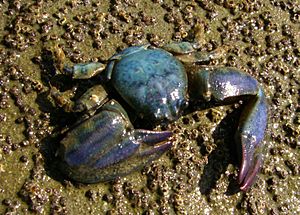Petrolisthes elongatus facts for kids
Quick facts for kids Petrolisthes elongatus |
|
|---|---|
 |
|
| Scientific classification | |
| Kingdom: | |
| Phylum: | |
| Subphylum: | |
| Class: | |
| Order: | |
| Family: |
Porcellanidae
|
| Genus: |
Petrolisthes
|
| Species: |
P. elongatus
|
| Binomial name | |
| Petrolisthes elongatus (H. Milne-Edwards, 1837)
|
|
| Synonyms | |
|
Porcellana elongata H. Milne-Edwards, 1837 |
|
The New Zealand half crab, also called the elongated porcelain crab or blue half crab, is a type of porcelain crab. Its scientific name is Petrolisthes elongatus. This interesting crab is originally from New Zealand.
Contents
What Does It Look Like?
The New Zealand half crab has a flat, smooth shell on its back, called a carapace. This shell can be up to 18 millimeters (about 0.7 inches) wide. From the front corners of its shell, long, whip-like feelers called antennae stick out. It also has a short nose-like part, called a rostrum, that goes past its big, noticeable eyes.
How It Eats
This crab eats in a couple of ways. It can filter tiny food bits from the water using special hairs on its mouthparts, called maxilliped palps. Or, it can scavenge for food. This means it chops up dead animals with its second maxilliped and then shreds the food even more with its mandibles (jaws).
Claws and Legs
The crab has large claws, called chelipeds. These claws are usually smooth and don't have teeth. Male crabs often have one claw that is bigger than the other. They use these claws mainly to defend their space from other crabs.
The claws and legs have spines that can break off. The top part of their body, including the claws and legs, can be black, blue, greenish, or grey. The underside is lighter in color. The last pair of legs is smaller and covered in hairs. These legs are folded under a large flap on their belly. This flap also helps the crab swim backward!
Life Cycle and Reproduction
Studies in New Zealand in the 1960s and 1970s showed that these crabs breed differently depending on where they live. In Auckland, female crabs carrying eggs (called ovigerous females) can be found all year. But near Kaikoura, they only carry eggs during the summer months.
Scientists believe that female crabs lay eggs two or three times in their lives. Each time, they can produce a lot of eggs, usually between 500 and 1000!
Where Does It Live?
The New Zealand half crab is native to all parts of New Zealand. This means it naturally lives there. However, it has also been found in Tasmania and Victoria, Australia. This happened because it was introduced to these places, likely by accident.
In New Zealand, you can find these crabs in many places. They live in mussel beds, on the poles that support wharves (docks), in estuaries (where rivers meet the sea), and on rocky shores where the tide goes in and out. They are very common under rocks and stones in these areas.
See also
 In Spanish: Petrolisthes elongatus para niños
In Spanish: Petrolisthes elongatus para niños

